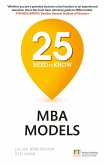Julian Birkinshaw, Ken Mark
Key MBA Models
The 60+ Models Every Manager and Business Student Needs to Know
Julian Birkinshaw, Ken Mark
Key MBA Models
The 60+ Models Every Manager and Business Student Needs to Know
- Broschiertes Buch
- Merkliste
- Auf die Merkliste
- Bewerten Bewerten
- Teilen
- Produkt teilen
- Produkterinnerung
- Produkterinnerung
Understand the key management models that make up your business school syllabus Effectively apply academic management models to your professional life Quickly identify the most relevant tools for you and find out how best to utilise them
Andere Kunden interessierten sich auch für
![Key MBA Models, Travel Edition Key MBA Models, Travel Edition]() Julian BirkinshawKey MBA Models, Travel Edition27,99 €
Julian BirkinshawKey MBA Models, Travel Edition27,99 €![25 Need-to-Know MBA Models 25 Need-to-Know MBA Models]() Julian Birkinshaw25 Need-to-Know MBA Models25,99 €
Julian Birkinshaw25 Need-to-Know MBA Models25,99 €![Inside the Tornado Inside the Tornado]() Geoffrey A. MooreInside the Tornado17,99 €
Geoffrey A. MooreInside the Tornado17,99 €![Winning Winning]() Jack WelchWinning22,99 €
Jack WelchWinning22,99 €![Reimagining Design Reimagining Design]() Kevin G. BethuneReimagining Design15,99 €
Kevin G. BethuneReimagining Design15,99 €![MBA Day by Day MBA Day by Day]() Chris DaltonMBA Day by Day25,99 €
Chris DaltonMBA Day by Day25,99 €![Business Schools post-Covid-19 Business Schools post-Covid-19]() Andreas Kaplan (France. ESCP Business School Paris)Business Schools post-Covid-1968,99 €
Andreas Kaplan (France. ESCP Business School Paris)Business Schools post-Covid-1968,99 €-
-
-
Understand the key management models that make up your business school syllabus Effectively apply academic management models to your professional life Quickly identify the most relevant tools for you and find out how best to utilise them
Hinweis: Dieser Artikel kann nur an eine deutsche Lieferadresse ausgeliefert werden.
Hinweis: Dieser Artikel kann nur an eine deutsche Lieferadresse ausgeliefert werden.
Produktdetails
- Produktdetails
- Verlag: Pearson Education Limited
- Seitenzahl: 296
- Erscheinungstermin: 21. Mai 2015
- Englisch
- Abmessung: 233mm x 156mm x 20mm
- Gewicht: 452g
- ISBN-13: 9781292016856
- ISBN-10: 129201685X
- Artikelnr.: 42017970
- Herstellerkennzeichnung
- Libri GmbH
- Europaallee 1
- 36244 Bad Hersfeld
- gpsr@libri.de
- Verlag: Pearson Education Limited
- Seitenzahl: 296
- Erscheinungstermin: 21. Mai 2015
- Englisch
- Abmessung: 233mm x 156mm x 20mm
- Gewicht: 452g
- ISBN-13: 9781292016856
- ISBN-10: 129201685X
- Artikelnr.: 42017970
- Herstellerkennzeichnung
- Libri GmbH
- Europaallee 1
- 36244 Bad Hersfeld
- gpsr@libri.de
Julian Birkinshaw is Professor and Chair of Strategy & Entrepreneurship at LBS. He's a Fellow of the British Academy & holds PhD & MBA degrees. He was recently placed 39th on the global “Thinkers 50” list of thought leaders in the field of management. Ken Mark is a businessman, entrepreneur, research & writer. He's written more than 100 case studies for use in MBA classrooms.
PART ONE ORGANISATIONAL BEHAVIOUR
1 Change management: Kotter’s eight-step model
2 Cognitive biases in decision making
3 Emotional intelligence
4 Managing work groups: Belbin team roles
5 Matrix management
6 Mintzberg’s managerial roles
7 Motivation: Theory X and Theory Y
8 Negotiating techniques: BATNA
9 Schein’s model of organisational culture
10 360-degree assessment
PART TWO MARKETING
11 Customer lifetime value
12 Ethnographic market research
13 Market orientation
14 Multichannel marketing
15 Met promoter score
16 The 4Ps of marketing
17 Pricing strategies: dynamic pricing
18 Product life cycle
19 Segmentation and personalised marketing
PART THREE STRATEGY AND ORGANISATION
20 The ambidextrous organization
21 The BCG growth-share matrix
22 Blue ocean strategy
23 Core competence and the resource-based view
24 Corporate social responsibility: the triple bottom line
25 Corporate strategy: parenting advantage
26 Five forces analysis
27 Game theory: the prisoner’s dilemma
28 Generic strategies
29 The McKinsey 7S framework
PART FOUR INNOVATION AND ENTREPRENEURSHIP
30 Brainstorming
31 Design thinking
32 Disruptive innovation
33 Greiner’s growth model
34 Open innovation
35 The seven domains assessment model for entrepreneurs
36 Stage/gate model for new product development
37 Scenario planning
PART FIVE ACCOUNTING
38 The accrual method in accounting
39 Activity-based costing
40 The balanced scorecard
41 The DuPont identity
42 Economic value added
43 Ratio analysis
PART SIX FINANCE
44 Black-Scholes options pricing model
45 Bond valuation
46 Capital asset pricing model
47 Capital budgeting
48 Modern portfolio theory
49 Modigliani-Miller theorem
50 Time value of money
51 Valuing the firm
52 Weighted average cost of capital
PART SEVEN OPERATIONS
53 Agile development
54
1 Change management: Kotter’s eight-step model
2 Cognitive biases in decision making
3 Emotional intelligence
4 Managing work groups: Belbin team roles
5 Matrix management
6 Mintzberg’s managerial roles
7 Motivation: Theory X and Theory Y
8 Negotiating techniques: BATNA
9 Schein’s model of organisational culture
10 360-degree assessment
PART TWO MARKETING
11 Customer lifetime value
12 Ethnographic market research
13 Market orientation
14 Multichannel marketing
15 Met promoter score
16 The 4Ps of marketing
17 Pricing strategies: dynamic pricing
18 Product life cycle
19 Segmentation and personalised marketing
PART THREE STRATEGY AND ORGANISATION
20 The ambidextrous organization
21 The BCG growth-share matrix
22 Blue ocean strategy
23 Core competence and the resource-based view
24 Corporate social responsibility: the triple bottom line
25 Corporate strategy: parenting advantage
26 Five forces analysis
27 Game theory: the prisoner’s dilemma
28 Generic strategies
29 The McKinsey 7S framework
PART FOUR INNOVATION AND ENTREPRENEURSHIP
30 Brainstorming
31 Design thinking
32 Disruptive innovation
33 Greiner’s growth model
34 Open innovation
35 The seven domains assessment model for entrepreneurs
36 Stage/gate model for new product development
37 Scenario planning
PART FIVE ACCOUNTING
38 The accrual method in accounting
39 Activity-based costing
40 The balanced scorecard
41 The DuPont identity
42 Economic value added
43 Ratio analysis
PART SIX FINANCE
44 Black-Scholes options pricing model
45 Bond valuation
46 Capital asset pricing model
47 Capital budgeting
48 Modern portfolio theory
49 Modigliani-Miller theorem
50 Time value of money
51 Valuing the firm
52 Weighted average cost of capital
PART SEVEN OPERATIONS
53 Agile development
54
PART ONE ORGANISATIONAL BEHAVIOUR
1 Change management: Kotter’s eight-step model
2 Cognitive biases in decision making
3 Emotional intelligence
4 Managing work groups: Belbin team roles
5 Matrix management
6 Mintzberg’s managerial roles
7 Motivation: Theory X and Theory Y
8 Negotiating techniques: BATNA
9 Schein’s model of organisational culture
10 360-degree assessment
PART TWO MARKETING
11 Customer lifetime value
12 Ethnographic market research
13 Market orientation
14 Multichannel marketing
15 Met promoter score
16 The 4Ps of marketing
17 Pricing strategies: dynamic pricing
18 Product life cycle
19 Segmentation and personalised marketing
PART THREE STRATEGY AND ORGANISATION
20 The ambidextrous organization
21 The BCG growth-share matrix
22 Blue ocean strategy
23 Core competence and the resource-based view
24 Corporate social responsibility: the triple bottom line
25 Corporate strategy: parenting advantage
26 Five forces analysis
27 Game theory: the prisoner’s dilemma
28 Generic strategies
29 The McKinsey 7S framework
PART FOUR INNOVATION AND ENTREPRENEURSHIP
30 Brainstorming
31 Design thinking
32 Disruptive innovation
33 Greiner’s growth model
34 Open innovation
35 The seven domains assessment model for entrepreneurs
36 Stage/gate model for new product development
37 Scenario planning
PART FIVE ACCOUNTING
38 The accrual method in accounting
39 Activity-based costing
40 The balanced scorecard
41 The DuPont identity
42 Economic value added
43 Ratio analysis
PART SIX FINANCE
44 Black-Scholes options pricing model
45 Bond valuation
46 Capital asset pricing model
47 Capital budgeting
48 Modern portfolio theory
49 Modigliani-Miller theorem
50 Time value of money
51 Valuing the firm
52 Weighted average cost of capital
PART SEVEN OPERATIONS
53 Agile development
54
1 Change management: Kotter’s eight-step model
2 Cognitive biases in decision making
3 Emotional intelligence
4 Managing work groups: Belbin team roles
5 Matrix management
6 Mintzberg’s managerial roles
7 Motivation: Theory X and Theory Y
8 Negotiating techniques: BATNA
9 Schein’s model of organisational culture
10 360-degree assessment
PART TWO MARKETING
11 Customer lifetime value
12 Ethnographic market research
13 Market orientation
14 Multichannel marketing
15 Met promoter score
16 The 4Ps of marketing
17 Pricing strategies: dynamic pricing
18 Product life cycle
19 Segmentation and personalised marketing
PART THREE STRATEGY AND ORGANISATION
20 The ambidextrous organization
21 The BCG growth-share matrix
22 Blue ocean strategy
23 Core competence and the resource-based view
24 Corporate social responsibility: the triple bottom line
25 Corporate strategy: parenting advantage
26 Five forces analysis
27 Game theory: the prisoner’s dilemma
28 Generic strategies
29 The McKinsey 7S framework
PART FOUR INNOVATION AND ENTREPRENEURSHIP
30 Brainstorming
31 Design thinking
32 Disruptive innovation
33 Greiner’s growth model
34 Open innovation
35 The seven domains assessment model for entrepreneurs
36 Stage/gate model for new product development
37 Scenario planning
PART FIVE ACCOUNTING
38 The accrual method in accounting
39 Activity-based costing
40 The balanced scorecard
41 The DuPont identity
42 Economic value added
43 Ratio analysis
PART SIX FINANCE
44 Black-Scholes options pricing model
45 Bond valuation
46 Capital asset pricing model
47 Capital budgeting
48 Modern portfolio theory
49 Modigliani-Miller theorem
50 Time value of money
51 Valuing the firm
52 Weighted average cost of capital
PART SEVEN OPERATIONS
53 Agile development
54








